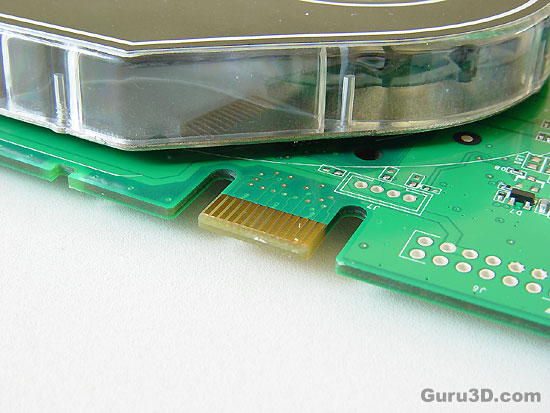Page 2
Into the brains of the creature
Right let's handle a little overview on the 7800 GT. The second product in the Series 7 product range, the GeForce 7800 GT contains 7 vertex units and 20 pixel pipelines. It operates with a core clock of 400MHz, a memory clock of 500MHz (256MB 256-bit 2ns (8x32) GDDR3 Memory (500MHz clock - 1 GHz effective)) and uses 256-bit GDDR3. Memory bandwidth can peak at a lovely 32GB/sec. The GeForce 7800 GT also includes 128-bit floating-point (32 bits/component) through the entire graphics pipeline which is a hundred percent similar to the 7800 GTX. The graphics core was manufacturer at 0.11 micron. Judging from the specs this little creature will even punk out the GeForce 6800 Ultra which is priced similar.
 Despite the speculation, the GeForce 7800 GT series has SLI capability.
Despite the speculation, the GeForce 7800 GT series has SLI capability.
As stated on the first page, the 7800 GT has a GeForce 7800 GTX core yet with some performance influencing factors disabled. Therefore this core is still is codename G70. Since feature wise we are looking at the same product, let's place all the technical differences in a table.
|
NVIDIA GeForce 6 & 7 Product Lineup Specifications |
Product Name
# pixel processors
# vertex processors
Bus width
Memory Type/Amount
GPU Speed
RAM Speed
GeForce 7800 GTX 24 8 256-bit GDDR3/256MB 430MHz 1200MHzGeForce 7800 GT 20 7 256-bit GDDR3/256MB 400MHz 1000MHzGeForce 6800 Ultra
16
6
256-bit
GDDR3/256MB
400MHz
1100MHz
GeForce 6800 GT
16
6
256-bit
GDDR3/256MB
350MHz
1000MHz
GeForce 6800
12
5
256-bit
GDDR/128MB
325MHz
700MHz
GeForce 6800 LE
8
4
256-bit
GDDR/128MB
320MHz
700MHz
GeForce 6600 GT 8 3 128-bit GDDR3/128/256MB 500MHz 1000MHzGeForce 6600 8 3 128-bit GDDR/128MB 300MHz 275(550) GeForce 6200 4 3 64/128-bit GDDR/128MB/256MB 300MHz 275(550)
| What is a shader ? |
| What do we need to render a three dimensional object; 2D on your monitor? We start off by building some sort of structure that has a surface, that surface is being built from triangles and why triangles? They are quick to calculate. How's each triangle being processed? Each triangle has to be transformed according to its relative position and orientation to the viewer. Each of the three vertices the triangle is made up of is transformed to its proper view space position. The next step is to light the triangle by taking the transformed vertices and applying a lighting calculation for every light defined in the scene. At last the triangle needs to be projected to the screen in order to rasterize it. During rasterization the triangle will be shaded and textured. |
